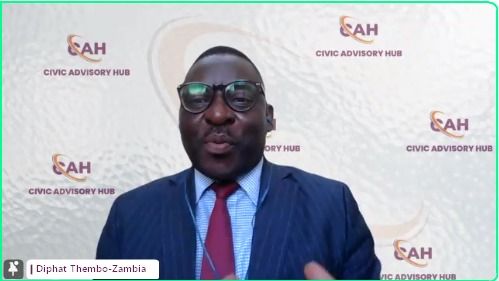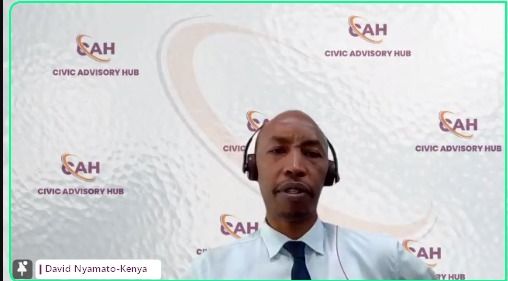On Thursday, 22nd May 2025, the Civic Advisory Hub (CAH) hosted its monthly webinar series; The Leaders Talk (TLT) webinar, focusing on the theme: “Unpacking the Intended and Unintended Consequences of the FATF Grey List.” Attended by over 60 participants, the session aimed to raise awareness about the implications of being placed under the Financial Action Task Force (FATF) grey list—a designation for countries under increased monitoring due to weaknesses in Anti-Money Laundering and Countering the Financing of Terrorism (AML/CFT) systems. The full webinar is available for viewing here.
What Does FATF Grey-listing Mean? | Emil Meddy, Senior Research and Documentation Officer, GIABA

Emil Meddy highlighted that the FATF Grey List—also known as the International Cooperation Review Group (ICRG) process—signals that a country has identified shortcomings in its AML/CFT framework.
Importantly, grey-listing is not a condemnation but a commitment: countries agree to an action plan with FATF to resolve these gaps.
Meddy clarified that FATF-style regional bodies (FRSBs) play a key role by engaging national stakeholders—including governments, regulators, and financial institutions—to address the identified deficiencies as fast as possible.
He also highlighted that grey-listing has positive implications; it creates leverage to push for institutional reform and financial transparency. However, he also acknowledged that the implications are disproportionately harmful for low-income, donor-dependent countries - evidenced by 57% of the countries on the list being in Africa.
To mitigate this, FRSBs work to ensure FATF standards are adapted to regional contexts. They facilitate fair peer reviews (Mutual Evaluation Process), promote evidence-based evaluations, and publish annual typologies and reports that reflect real progress on the ground. Peer-to-peer learning and capacity building are also central to this regional approach.
Economic Consequences and Mitigation Strategies | Mr. Diphat Thembo, Director, Compliance and Prevention Department, FIC-Zambia

Mr. Diphat Thembo elaborated on the economic consequences of grey-listing, particularly for African nations. Key outcomes include limited access to direct aid, increased national budgetary pressures, and declining foreign direct investment due to reputational damage and risk aversion by global investors.
To mitigate these effects, Thembo advised grey-listed countries to:
- Generate credible statistical data on Sustainable Development Goals (SDGs) and economic performance that assessors can access.
- Conduct regular mutual evaluations to maintain updated risk profiles.
- Periodically conduct National Risk Assessments especially of Non-Profit Organizations (NPOs), recognizing that not all NPOs pose high AML/CFT risks.
Thembo stressed the importance of country-led data and analysis in shaping fair and context-sensitive responses from the global AML/CFT framework.
De-risking and the Risk of Grey List-Induced Panic | David Nyamato, Head of Governance, Regulatory Affairs, NCBA Bank Kenya

David Nyamato highlighted the ripple effects of grey-listing on national reputation and the banking sector. In African contexts, banks often become the first line of scrutiny. While the intent is to strengthen AML/CFT frameworks, the reality brings several unintended consequences:
- Financial strain on institutions: Especially in Kenya, smaller Tier 3 banks were driven out of business due to the high cost of compliance and capacity-building.
- Operational burdens: Enhanced due diligence processes are hampered by weak national identification systems, making transaction monitoring inefficient and costly.
- De-risking and financial exclusion: International banks may exit local markets, and domestic institutions may close accounts of clients deemed “risky,” further excluding already underserved populations.
Nyamato shared that Grey List-Induced Panic (GLIP) may manifest as; capital flight, heightened scrutiny, and service disruptions.
“Banks not only need to identify their customers and what they do but they must also understand their customers’ customers.”
He warned that sensationalist media coverage exacerbates GLIP, feeding public anxiety and undermining investor confidence. The solution? A unified, evidence-based narrative that brings together regulators, financial institutions, and development actors to communicate progress and manage perceptions.
Conclusion: Turning Compliance into an Opportunity

The TLT webinar revealed that while FATF grey-listing is a corrective tool, its socio-economic implications—especially in Africa—are far-reaching. Stakeholders must go beyond ticking-the-box compliance and pursue reforms rooted in regional realities. With a coordinated approach and a commitment to transparency, countries can not only exit the grey list but emerge stronger, more resilient, and more financially inclusive.
The discussion sends a clear message: FATF compliance must empower, not paralyze. And shifting the narrative—from stigma to opportunity—will be key in Africa’s ongoing financial transformation.
